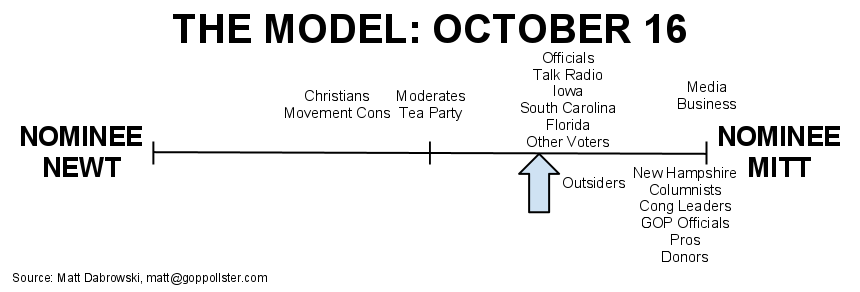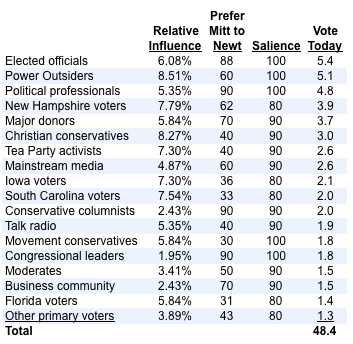
Can game theory predict the outcome of the Republican presidential primary? The answer is yes. As of today Newt Gingrich hasn't lost his front-runner status, but Mitt Romney will swing the election decisively in his favor just by performing as well as Gingrich in the early primary states. If Gingrich stays in the lead, however, he can transform the contest into a rejection of Romney's front-runner status.
[Interests disclosed: I was the pollster for Newt Gingrich's American Solutions in 2007 but am not aligned with a campaign in 2012.]
The discipline of game theory is about bringing mathematics to strategic thinking. It assumes that people are competitive and act in what they perceive is their best interests. Using these assumptions, we can use math to predict behavior.
Using the game theory perspective to make political predictions isn't new to academia. New York University professor Bruce Bueno de Mesquita, its most prominent proponent, has been doing this type of modeling for more than 30 years, and has been called the new Nostradamus for his specific and accurate predictions on matters of war and peace. He points to CIA analysts who have found his model to be "accurate 90% of the time."
Here's an example. Say your family is deciding where to go on vacation. Mom, Granddad, your wealthy uncle, and your slacker cousin each have their top choices: Paris, Houston, Beverly Hills and Las Vegas. Certainly they all have different amounts of influence on the decision-making process, and they have different levels of enthusiasm about making sure their preference is the final pick. If we put numbers on our vacation scenario and do a little math, we can make a prediction about where the family will go this year.
This type of model is called an expected utility model, and it's useful for politics, international affairs, and even business negotiations. So let's create our own expected utility model for the Republican primary.
In my model, there are 18 groups that have at least some influence on picking the Republican nominee: interest groups like the business community, Christian conservatives, major donors, moderates, movement conservatives, key grassroots activists, and Tea Party members; political people like the Republican leadership in Congress, Republican elected officials in the states, and political professionals and campaign operatives; media such as prominent conservative columnists, the mainstream media outlets, and talk radio; and primary voters in Iowa, New Hampshire, South Carolina, Florida, and other primary states.
I asked a handful of consultant, journalist and academic colleagues of mine with knowledge of Republican politics to help me put some numbers on the process. My kitchen cabinet and I rated each group's relative influence on the process, and its preference between Newt Gingrich and Mitt Romney. (By necessity, we can only consider two candidates at a time.)
New Hampshire primary voters, for example, have more influence on the process than conservative columnists like George Will and Charles Krauthammer. On the other hand, professional political operatives have more interest in who'll be the nominee than New Hampshire voters, since their jobs will be affected in one way or another. This differing level of interest in turning one's preferences into reality is called salience.
Let's lay out our influencers' preferences on a continuum between our two front-runners, from zero for Gingrich to 100 for Romney. Influencers can have an overwhelming preference for a candidate, a strong preference, some support, or just an aversion to the other candidate (a light preference). The middle point 50 reflects no preference between our two candidates.
Some of these decisions must be judgment calls. Nonetheless, though the group held wildly different opinions on how the primary season will play out, our opinions on relative influence of each groups and their preferences were largely the same. Knowledgeable people often disagree on their conclusions, but rarely on the facts.
For the voters, we can use public polling to quantify their preferences. I used the averages from Huffington Post Election Dashboard and Dr. Charles Franklin in the early primary states. The Huffington Post-Patch Power Outsiders Poll can tell us something about key grassroots activists, too.
Now that we've put numbers on the relative influence of the players, their preferences, and the salience of their preferences, we can make some predictions.
To start, let's compare two points in time: today and Oct. 16. Since Gingrich and Romney are our front-runners, Oct. 16 is a good starting point because the public polling had yet to show momentum for Newt.
On Oct. 16, Gingrich was left for dead. Written off by the media, the political professionals and the donors, he was polling at only 6 percent in New Hampshire. The overall score on that date is 65, showing a 'strong' overall preference for Mitt Romney.
The midpoint of 50 is our dividing line: less than 50, and Gingrich is the likely nominee based on all the influencers' preferences; more than 50 means Romney is the likely winner. (Remember that scores of zero or 100 would reflect something that likely won't happen until the convention itself: an overwhelming preference for one candidate held by all of the influencers.)
This graphic shows the various groups laid out on a continuum between Gingrich and Romney. Most influencers lean far towards Romney. In a competitive world, they perceive their best interests as being aligned with the live Romney over the struggling Gingrich.

But then the Newt surge happened. As Gingrich rose in the polls, he picked up endorsements from elected officials and good headlines from the press. Movement conservatives have been meeting with Gingrich, as have Christian groups and members of the business community. A group of major donors formed a Gingrich super-PAC.
Today, post-surge, the model sits at 48, suggesting that Gingrich is still the likely nominee today.

But for how long? The latest public polls have shown Gingrich's numbers dropping relative to Romney's, after two weeks of heavy anti-Newt media buys in the early primary states. This week's Power Outsiders poll also shows movement towards Romney. Together they've swung the model two points in five days (from 46). Gingrich remains the predictive nominee, but that dividing line of 50 is very close.
So now, armed with this information, what can the candidates do to win?
I ran a number of scenarios to predict what might happen if Romney bested Newt in the early primary states, and the best result for Romney was 76: an easy ride to the nomination.
Romney needs to win primaries. If Romney merely ties with Gingrich in the early primary states, the model easily swings back over 50. Romney is the natural preference for a number of our influencers: political professionals, elected officials, and donors, just to name a few. He needs the voters to follow these influencers. After a couple of underwhelming primary results, the mainstream media would use the opportunity to throw dirt on Newt's coffin. If the voters go along with them, there's no space for Gingrich to win.
Of the scenarios I tested, Gingrich could get as high as a 41: a victory, but with far less padding than Romney's. Gingrich's nomination will be perceived as a rejection of Romney.
Gingrich needs to win primaries too, but for the opposite reason. He needs influencers to follow the voters. If repeated success neutralizes Romney's advantages among elected officials, the business community and donors, Gingrich will win the nomination. Newt doesn't need to win these groups; their ambivalence between the two candidates would be enough. Success would also deepen the preferences of groups that would naturally lean towards Gingrich, like movement conservatives and Tea Party activists.
Conclusion
My expected utility model provides another way to look at the Republican primary. When Newt was weak, the model confirmed it, and put a number on the magnitude of Romney's advantage. As Newt's support picked up, the model showed that too. It also quantifies the conventional wisdom: Gingrich's margin of error is far smaller than Romney's. All in all, this model is a decent snapshot of the Republican primary contest, and suggests how the primary may play out.
What do you think? How can I improve the predictive power of the model? Am I missing any critical influencers? Thanks in advance for your comments and suggestions. Happy Holidays.
--
Appendix: I've included a chart that gives you a glimpse of the variables I used, and their effects on the final number.

If you'd like to know more about the procedure, Bruce Bueno de Mesquita is the authority. His books are well-written and worth a read by anyone interested in this type of work. The Predictioneer's Game is a thorough introduction for the popular audience, while Predicting Politics is geared toward the political science crowd.